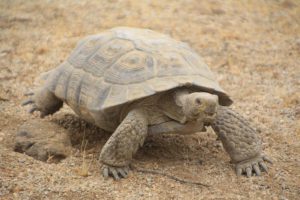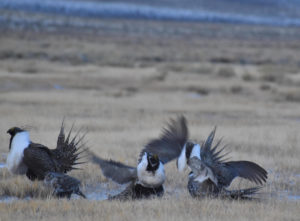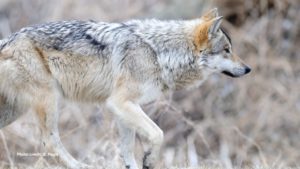For Immediate Release
March 29, 2023
Contact:
- Wendy Schneider, Friends of the Inyo, (310) 849-3662, wendy@friendsoftheinyo.org
- Ileene Anderson, Center for Biological Diversity, (323) 490-0223, ianderson@biologicaldiversity.org
- Laura Cunningham, Western Watersheds Project, (775) 513-1280, lcunningham@westernwatersheds.org
- Ian Brickey, Sierra Club, ian.brickey@sierraclub.org
Project Threatens Imperiled Sage Grouse and Endangered Fish
SAN FRANCISCO— Conservation groups filed an appeal Tuesday in the 9th U.S. Circuit Court of Appeals challenging a lower court ruling allowing exploratory drilling in California’s Sierra Nevada Mountains that threatens an endangered fish and a dwindling population of bi-state sage grouse.
The groups sued the U.S. Forest Service in 2021, saying the agency had ignored the mining project’s potential environmental harms to Inyo National Forest’s Long Valley area, including potential harm to the stream where endangered Owens tui chubs live.
“This project is unlawful and will permanently damage species and the ecosystem in southern Mono County,” said Wendy Schneider, executive director for Friends of the Inyo. “Furthermore, it will be harmful to the community. Mono County’s economy is based on recreational tourism. The proposed drilling will take place very near Hot Creek, a world renowned fly fishing destination. Lights, noise and dust will be present 24/7 for at least a year, visible from recreational spots all over the Mammoth Lakes area.” The Forest Service concluded no harm would be done by the project following a cursory review known as a categorical exclusion. These reviews are supposed to be reserved for minor federal projects, like rebuilding hiking trails or repaving parking lots.
“This mining exploration could easily disrupt the local bi-state sage grouse population, causing the birds to abandon a courtship area they rely on and degrading their habitat,” said Ileene Anderson, a senior scientist at the Center for Biological Diversity. “These birds are already struggling to survive, and further destruction of their habitat will only push them closer to extinction.”
Bi-state sage grouse, whose numbers have drastically declined in the past decade, live next to 12 proposed drilling pads. The birds are a genetically distinct population of greater sage grouse, famous for their showy plumage and mating dances. They live only in an area along the California-Nevada border and face multiple threats.
“Gold exploration and drilling would harm sensitive habitat for the imperiled bi-state distinct population of greater sage grouse, and could result in abandonment of this area by the birds,” said Laura Cunningham, California director at Western Watersheds Project. “We are also concerned about water quality in Hot Creek, a thermal stream and habitat of the Owens tui chub, a native fish unique to the Owens River system.”
The Forest Service attempted to shoehorn the mining exploration project into a “short term” categorical exclusion lasting less than a year, even though the remediation of the drilling sites would take much longer than a year in this snowy, remote area.
“Exploratory drilling for gold can cause a lot of harm to the environment in a year,” said Lynn Boulton, chair of the Sierra Club’s Range of Light Group, Toiyabe Chapter.
The groups are represented by Roger Flynn with the Western Mining Project, Talasi Brooks with Western Watersheds Project and Lisa Belenky at the Center for Biological Diversity.
The gold exploration project is proposed on land in Long Valley, California, with high cultural value to the Kutzadika’a Tribe of Northern Paiute, as well as to other Paiute and Shoshone people.
—
The Center for Biological Diversity is a national, nonprofit conservation organization with more than 1.7 million members and online activists dedicated to the protection of endangered species and wild places.
Western Watersheds Project is a nonprofit conservation group with over 12,000 followers, with field offices across the western U.S. We work to influence and improve public lands management throughout the West with a primary focus on the negative impacts of livestock grazing on 250 million acres of western public lands, including harm to ecological, biological, cultural, historic, archeological, scenic resources, wilderness values, roadless areas, Wilderness Study Areas and designated Wilderness.
Founded in 1986, Friends of the Inyo is a nonprofit grassroots environmental organization. Our mission is to protect and care for the lands of Payahuunadu, also known as California’s Eastern Sierra. Our working area covers Inyo and Mono Counties, stretching from Lone Pine to Bridgeport, including three national forests and two BLM field offices. On behalf of our approximately 4,000 members and supporters, we advocate for healthy environments across the diverse ecosystems that make up our working area. We also lead educational events and outings, including for local and visiting youth, and partner with federal agencies to engage in direct stewardship activities.
The Sierra Club was founded in 1892 and is the nation’s oldest grass-roots environmental organization. Sierra Club’s mission is to explore, enjoy, and protect the wild places of the Earth; to practice and promote the responsible use of the Earth’s ecosystems and resources; to educate and enlist humanity to protect and restore the quality of the natural and human environment; and use all lawful means to carry out these objectives. The Range of Light Group is a group within the Toiyabe Chapter that covers the geographic region of Inyo and Mono Counties.
###





